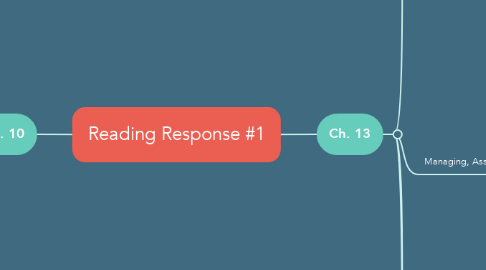
1. Ch. 10
1.1. Aesthetic Reading
1.1.1. What the character is going through
1.2. Efferent Reading
1.2.1. Carry away meaning
1.3. Close Reading
1.3.1. Close attention to text
1.3.2. Close attention to relevant experience
1.3.3. Look beyond basic meaning of text, use awareness for understanding
1.3.4. Find relevant connections to text
1.4. ?’s to Guide Reading and Discussion
1.4.1. Reader Response
1.4.1.1. Does this piece remind you of anyone you know?
1.4.1.2. What main feeling did it stir up?
1.4.2. Close Reading
1.4.2.1. What are some examples of foreshadowing?
1.4.2.2. What do you think the writer was trying to say?
1.5. Roles in Literature Discussion
1.5.1. Summarizing
1.5.1.1. Summarizing the text, what stood out
1.5.2. Analyzing Author’s Craft
1.5.2.1. What diction did the author use, strategies, techniques?
1.5.3. Questioning
1.5.3.1. What were your thoughts when reading through _____ passages.
1.5.4. Making Connections
1.5.4.1. Have you ever felt scared like the character did?
1.5.5. Looking Back
1.5.5.1. Referencing text to support your claims.
1.6. Types of Literature
1.6.1. Folklore
1.6.1.1. Word of mouth stories. Passed from one generation to the next, follows oral tradition
1.6.2. Poetry
1.6.2.1. Carries high volume of figurative language.
1.6.2.2. Read with passion, ask critical questions at end of reading
1.6.3. Chapter Books and Novels
1.6.3.1. Strategies used are questions proposed before and after reading
1.6.3.2. Students are commonly asked to read one chapter per day
1.6.3.3. “Set aside for separate unit of study”
1.6.4. Drama
1.6.4.1. Designed to be acted out as a skit or read aloud
1.6.4.1.1. Reader’s Theatre
1.6.4.2. Dramatization
1.6.5. Literary Nonfiction
1.6.5.1. Famous Speeches
1.6.5.2. Essays
1.6.5.3. Historical Documents
1.6.5.4. Biographies
2. Ch. 13
2.1. Constructing a Literacy Program
2.1.1. Setting Goals
2.1.1.1. Aquire basic info about students
2.1.1.1.1. Interest inventory
2.1.1.2. Collaborate with students, create a “shared vision” of what they want their literacy program to look like
2.1.2. Choosing Materials
2.1.2.1. High quality children’s books
2.1.2.1.1. Variety of topics, ability/age appropriate
2.1.2.2. Supplementary/alternate materials
2.1.2.2.1. DVD Players
2.1.2.2.2. Voice Recorders
2.1.2.2.3. Smart Boards
2.1.2.2.4. Document Cameras
2.1.3. Selecting Techniques & Strategies
2.1.3.1. Word Building
2.1.3.2. KWL
2.1.3.3. Close Reading
2.1.3.4. Reading to Students
2.1.3.5. Guided Writing
2.1.3.6. Think-Aloud
2.1.3.7. Direct Instruction
2.1.3.8. Know when to change strategies, when to substitute, if they’re appropriate for the students’ age.
2.1.4. Building Motivation
2.1.4.1. Create a positive and encouraging environment
2.1.4.2. Students set goals, visually shown improvement and progress towards goals
2.1.4.3. Motivating Classroom Elements
2.1.4.3.1. Manipulative’s/Hands On Items
2.1.4.3.2. Cooperation/Collaboration
2.1.4.3.3. Effort, praise and reinforcement
2.1.4.3.4. Routines and procedures
2.1.5. Building a Sense of Community
2.1.5.1. Build relationships with each individual students
2.1.5.1.1. Students will feel valued, learning personalized
2.2. Managing, Assessing, and Improving a Literacy Program
2.2.1. Using Time Efficiently
2.2.1.1. Zone of Proximal Development
2.2.1.1.1. Task too easy, too difficult, confusing, unsupportive of content = TIME WASTED
2.2.1.1.2. Avoid teaching what students already know
2.2.1.1.3. Teach content that may be just out of reach to understand, but what prompts for assistance from educated individual
2.2.1.2. Eliminate activities that have limited or no value
2.2.2. Flexible Grouping
2.2.2.1. Whole-Class Grouping
2.2.2.1.1. Build a sense of community
2.2.2.1.2. Class participation
2.2.2.2. Reading Achievement Groups
2.2.2.2.1. Guided reading, grouped to ability
2.2.2.2.2. Flexible, students can be transition to higher or level groups based off of progress
2.2.2.3. Summarize
2.2.2.4. Temporary Skills Group
2.2.2.4.1. Grouped based off of need for a skill
2.2.2.4.2. Once skill is mastered, group disbanded
2.2.2.5. Interest Groups
2.2.2.5.1. Group of students interested in a similar topic or genre
2.2.2.5.2. NOT based off of ability, strictly based off of INTEREST
2.2.2.6. Regrouping
2.3. Literacy and Technology
2.3.1. Assessing a websites validity and reliability
2.3.1.1. Predict
2.3.1.2. Questions
2.3.1.2.1. Assigning students from several classes who are reading on same grade level to instructional groups
2.3.1.3. Clarify
2.3.2. Web 2.0 Tools
2.3.2.1. Blogging
2.3.2.1.1. Creator adds content
2.3.2.1.2. Readers can reply by posting comments
2.3.2.2. Wikis
2.3.2.2.1. Hold an abundant amount of information
2.3.2.2.2. Can be EDITED
2.3.2.2.3. Can be OPEN or PRIVATE
2.3.2.3. Podcasts
2.3.2.3.1. Auditory, digital files
2.3.3. Issues of Safety
2.3.3.1. Monitoring Software
2.3.3.2. Gaggle
2.3.3.2.1. Student Safe:
2.4. Professional Development
2.4.1. Reflection
2.4.1.1. Self-Evaluations
2.4.1.2. Student Surveys
2.4.2. Setting Professional Goals
2.4.2.1. Where do I want to be in 5 years
2.4.2.1.1. How do I get there?
2.4.2.2. What new skills and techniques do I want to learn?
2.4.2.2.1. Teaching Conferences
2.4.2.2.2. Teaching Opportunities
2.4.2.2.3. Endeavors
